Category: Longform
You are viewing all posts from this category, beginning with the most recent.
"Princess and the Frog" Magic with the Pixel 8 Pro
My cousin’s sweet sixteen photoshoot was a special project, and I wanted to capture her unique spirit and personality. Inspired by “The Princess and the Frog,” we explored whimsical poses and angles throughout Old Town Occoquan.
To achieve the desired effect, I relied heavily on the Pixel 8 Pro’s versatile camera system. To highlight her expressions, I opted for the natural bokeh achieved through the phone’s zoom capabilities (1x and 5-10x), avoiding the artificial look of Portrait mode. The Peaking feature was essential for precise manual focus on her face, ensuring sharp details amidst the whimsical movements.
Beyond focus, capturing the right mood and lighting was crucial. Using the Pro-mode controls, I adjusted shadows and brightness to highlight her features without compromising her natural complexion. The magic continued in post-processing with Google Photos.
The Magic Editor effortlessly removed distracting elements like trash cans and light posts, while a touch of vignette added a final touch of mystique, drawing attention to her captivating expressions..






This photoshoot was more than just a technical exercise; it was a chance to connect with my cousin and celebrate her transition into womanhood. You can read more about the experience and what it meant to me on my personal blog.
Google's SafetyCore: Your Phone's New AI Bouncer (with a Side of Truth)
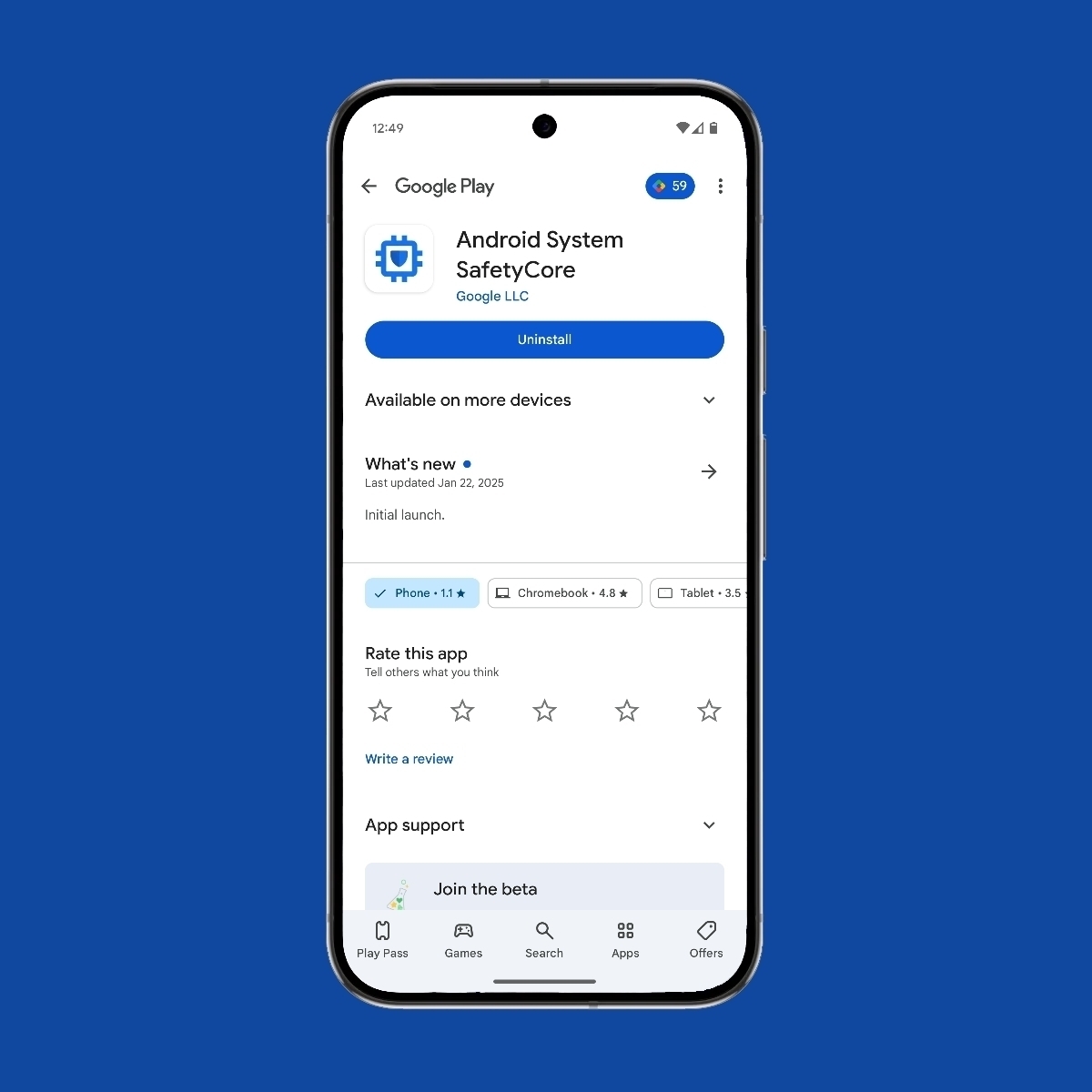
So there has been a lot of online chatter about Google’s newly released app called Android System SafetyCore that’s being downloaded on a lot Android devices. Mostly Android 9+ devices. And there’s been a lot of misinformation about it so I figured I’d provide more correct information on the web about it. In short, it’s like having a bouncer for your phone. You can read the entire blog post from Google about it on their Security Blog, but I’ll try to explain in less detail. In short, Google lists the following new protections:
- Enhances detection protects you from package delivery and job scams.
- Intelligent warnings alert you about potentially dangerous links.
- Controls to turn off messages from unknown international senders.
- Sensitive Content Warnings give you control over seeing and sending images that may contain nudity.
- More confirmation about who you’re messaging.
So this bouncer uses AI to spot shady stuff like spam, scams, malware, and even those NSFW pics (yikes!) in your messages and apps. The best part? It does all this without snitching to Google or anyone else. Think of it like a super-smart security guard who can spot trouble without calling the cops. By not snitching to Google or anyone else or calling the cops, it’s not sending your information to anyone. ANYONE.
Now, some people have been mistakenly thinking, “Isn’t this like that client-side scanning thing Apple tried to pull?” Nah, not even close. That was all about scanning your pics and reporting potentially illegal stuff, which was a major privacy no-no.
Android’s SafetyCore is different. It keeps everything on your phone and doesn’t share anything with anyone. It’s more like Apple’s Communication Safety feature in iMessage, which warns kids about sensitive content but doesn’t share anything with Apple.
Unfortunately, like I said, there’s been some misinformation floating around about SafetyCore, with some folks calling it “spyware.” But that’s simply not true. As the privacy-focused folks at GrapheneOS put it:
The app doesn’t provide client-side scanning used to report things to Google or anyone else. It provides on-device machine learning models usable by applications to classify content as being spam, scams, malware, etc. This allows apps to check content locally without sharing it with a service and mark it with warnings for users.
The GrapheneOS team are experts in this field, and they clearly state that SafetyCore doesn’t share your data. So, you can rest assured that your privacy is protected.
The GrapheneOS team does wish Google would make the whole thing open source, which would increase transparency and trust. I agree with this too, but here’s the thing: apps have been able to do this AI security stuff for a while now, but they usually send your data to their servers. SafetyCore keeps everything local, which is a big win for privacy.
Okay, so circling back to that “not snitching to the cops” part: SafetyCore isn’t about reporting illegal stuff to the authorities. It’s simply about giving your phone the ability to spot potentially harmful stuff and give you a heads up. Remember that and take that how you will.
So, there you have it! The TL;DR is Google’s Android System SafetyCore seems like a pretty sweet deal for boosting your phone’s security and privacy. Don’t let the misinformation scare you away from a potentially useful tool. It’ll be interesting to see how it evolves and how other apps start using it.
Down Memorable Tech Lane
Jason Howell had David Piece, from The Verge, on his podcast today to chat about memorable tech. It got me wondering what was my most memorable tech.
I couldn’t think of a single one that I’d call memorable. Yea, I’ve had some great smartphone experiences, but those are still fresh. After going through my mental Rolodex – even typing that makes me feel old – I was able to remember the Dell Inspiron e1405, my first personal laptop that I got for college in 2006. I loved it so much. The large (at the time) screen, sleek design, media controls on the front, and full Windows XP. …Just to refresh my memory of it, I had to look up the specs. It’s funny how these numbers can bring back a flood of memories. Check out what this machine was packing back in 2006:
- Intel Core Duo T2300 CPU (1.66GHz)
- 14.1" WXGA LCD (1280x800) Display
- 1GB DDR2 SDRAM
- Intel GMA950 integrated graphics
- 100GB 5400rpm SATA hard drive
- Windows XP Media Center Edition
- 10/100 BaseT Ethernet
- Combo CD-RW/DVD-ROM optical drive
- 802.11b/g wireless card
- 85WHr 9-cell Lithium-Ion battery


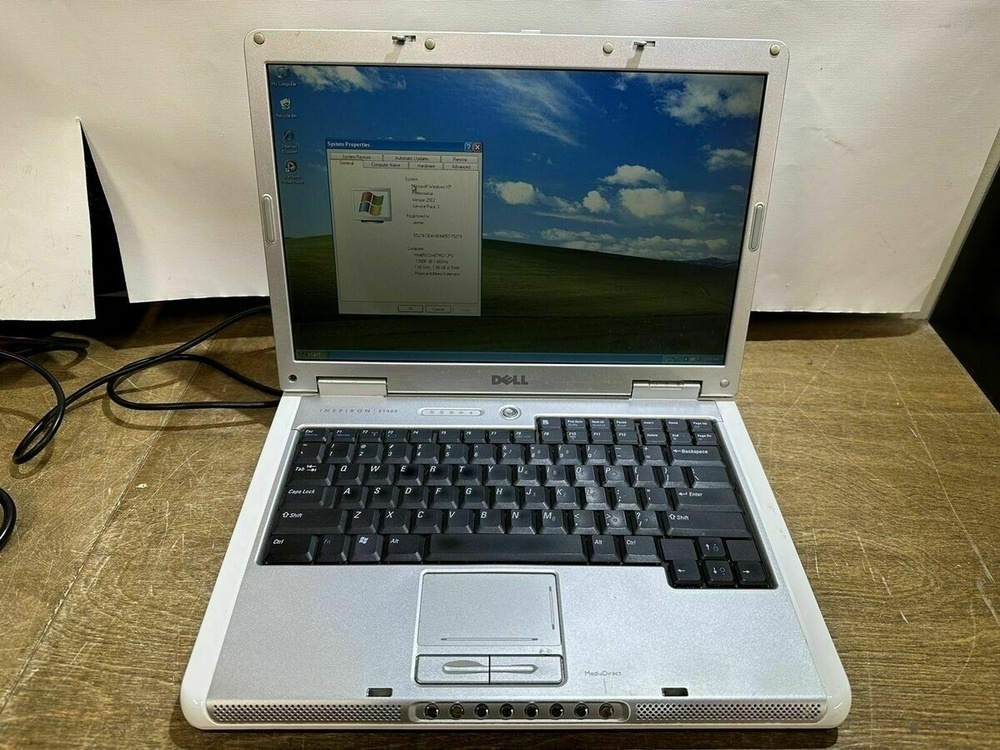
This isn’t my exact laptop. I pulled this image from Ars Technica. I’m still digging around to see if I can find it. Once I find it, I’ll definitely update this post. Either way, I have fond memories with this laptop. Not only was it my first personal computer, but it was the computer I took my first Computer Science courses at University of Mary Washington. The memories of being frustrated trying to set up Putty SSH client on this machine as a freshmen came rushing back as soon as I saw thought about this laptop. It ran smoothly, I just didn’t know what I was doing then. When I should have been studying, I used this laptop as a gaming laptop, before I knew about gaming laptops. It was my first forray into MMORPG (massively multiplayer online role-playing game) with The Matrix Online. Easily one of my favorite games I’ve ever played. I could go on and on about that game, but it was also my first experience with having an online community. From the forums, the chatrooms, and even podcasts. It was just an amazingly nerdy time. Just allow me to nerd out for a moment.
Back to the laptop. If I remember correctly, I held onto this machine until 2011. Towards the end of my relationship with this lovely machine, I replaced the hard drive after years of heavy use. I installed Ubuntu OS, and even purchased a new battery from eBay to try to salvage it. After a couple of months of troubleshooting driver issues, the motherboard officially called it quits and made it’s way tech heaven. It pushed through so much. Burning CDs, LimeWire, Skype Video calls, coding projects, online exams, etc…
Now I know how Jason Howell feels when he talks about his Commodore 64. If you can, check out his podcast and this conversation with David Pierce. It will definitely get you thinking about your old fond memories of technology.
What was your most memorable piece of tech?
Apple Might Be Bringing Ads to Apple Maps
So, word on the street is that Apple might be bringing ads to Apple Maps, according to Mark Gurman over at Bloomberg’s Power On newsletter.
This has, shall we say, ruffled some feathers. Think of it – just like on Google Maps, businesses could potentially pay to get their spots bumped up in search results or highlighted on the map itself.
Gurman also mentioned that there’s no set timeline, and they haven’t even started the engineering work yet.
Now, the internet, being the internet, has opinions.
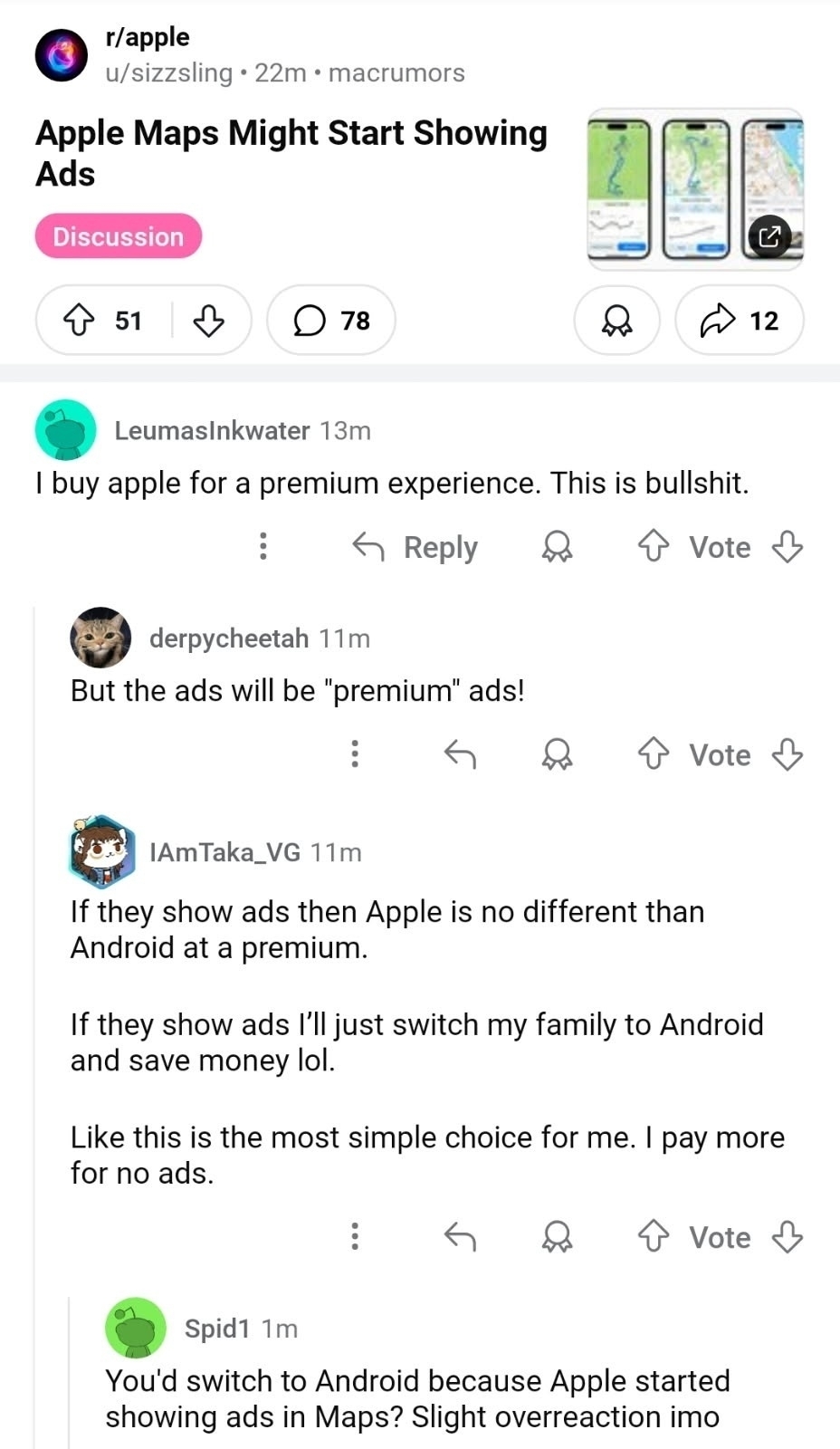
"The Price of Friendship", a short story
I’ve added a new “Web” category for this tech blog and I want to use this category as a place for images, someone else’s blog or creative writing, across the web that I enjoyed that revolve around tech. Today, it’s a short story. With that said, a friend of mine uploaded what could potentially be a creative series (I hope), but so far this short story is amazingly well written. I’ve never known him for being a creative writer, but for this to be his first, I was thoroughly impressed. The scene setting is so good. Just read this small excerpt and be amazed:
“I attempt to reconnect to Quinn’s model, but I only receive an error message: “MODEL UNAVAILABLE. Contact DataHive™ support to speak with a Neurogenic AI specialist.” No, thanks. This doesn’t seem like a “turn it off and on again” type of situation. I remove my headset and sit in silence for what feels like only a few minutes, just staring off into space, a million thoughts and possibilities running through my head. When I snap out of it, I realize I have been sitting there for an hour."
That’s only a small piece of it, but it’s so good. I recommend you read it. @jcrabapple@dmv.community, if you’re reading this. You better turn this into a series, bro! 😁
The Price of Late Refinement: How Android's Early Hardware Struggles Still Impact the Ecosystem
I had a good conversation with Ankit Gupta on Threads where he brought up something interesting:
One of the major issues Android faced early on while trying to compete with iPhone/iOS was build quality of Android phones. After a few years, Google finally decided to step up and partnered with some OEMs to manufacture their Nexus phones; even bought Motorola. Overall, I would argue that Google is still paying the price of not having good hardware manufacturers for Android at the get go. The conversation started here but was really led by Google potentially doing the same thing with their self-driving technology with Waymo and not partnering with the right partners or better yet making their own car like Tesla and Rivian.
Google’s initial approach with Android seems to stem from a lack of hardware experience at a time when hardware was the primary focus. Google represents the progression and evolution of Microsoft’s focus on software. However, in today’s information age, if Google had focused on hardware earlier and failed, would their brand recognition and hardware be stronger today? I think so. Nevertheless, I’m unsure if Android would have achieved its current scale with numerous OEMs if Google had solely controlled everything and prioritized its own hardware.
It’s obviously a game of what-ifs, but maybe in an alternative universe, Google started the Pixel line before even the inception of Nexus. Which would not only help with the brand recognition in the long run, but would cause Steve Jobs to really pop a blood vessel.
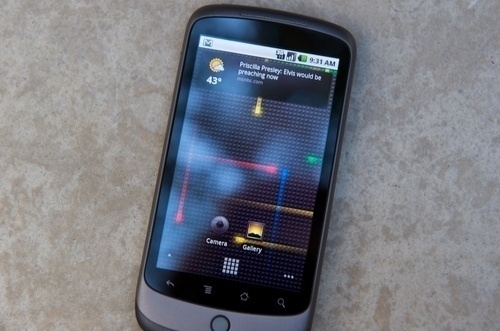
YouTube is Adding Veo 2 to Shorts
Dina Berrada, Director of Product, Generative AI Creation, at YouTube:
Today, Dream Screen is getting another major upgrade with the integration of Google DeepMind’s newest video generation model, Veo 2, making it more powerful than ever. And we’re also now launching a new capability powered by Veo 2: generating standalone video clips that you can add to any of your Shorts.
Together with Dream Screen, Veo 2 generates state-of-the-art, high-quality videos in a wide range of subjects and styles that better match your vision. Plus, we’ve also made improvements so Dream Screen now generates videos faster than before. Veo 2 understands real-world physics and human movement better, making its output more detailed and realistic. You can even specify a style, lens, or cinematic effect, making Dream Screen an easy and fun way to express yourself.
I see this as an evolution to creativity coming down to a commodity. Adding CGI used to require an entire team and countless hours of getting the physics right. Now you can do it with just your phone and a little imagination.
Breaking Out of Basic
I’m Finally Embracing Colorful Tech
For years, I’ve been a creature of habit when it comes to my tech. Black phone, black watch, maybe a black case if I was feeling wild. It’s not that I dislike black – it’s classic, sleek, and goes with everything. But lately, I’ve been feeling…bored. Like my tech accessories are starting to look as dull as my winter wardrobe.
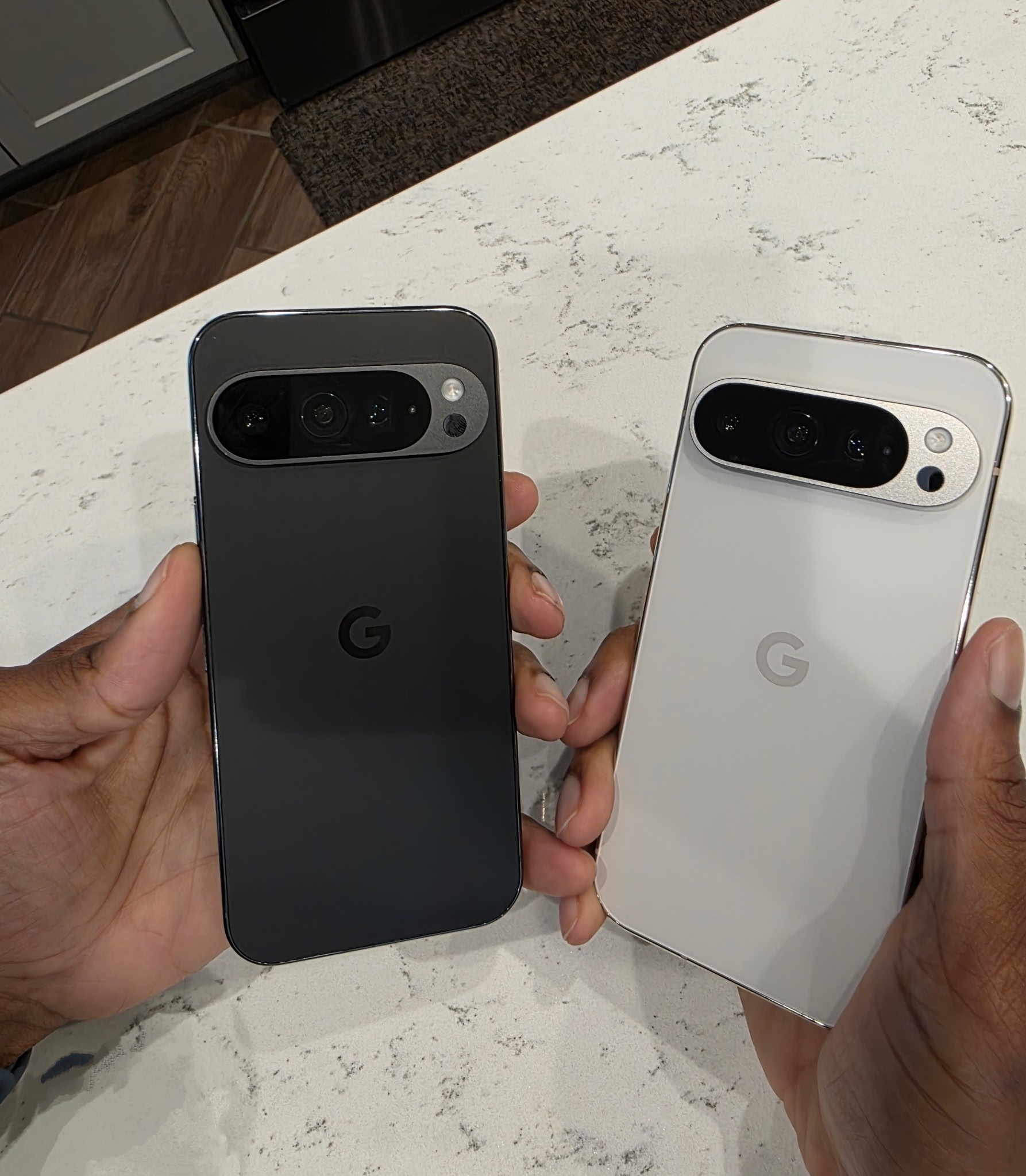
Then, something happened. I was hanging out with my friend Rob, and we were admiring his white Pixel 9 Pro. Side-by-side with my black one, it looked so fresh and modern! Suddenly, I had a pang of phone envy. Unfortunately, I’m locked into my Verizon plan, so a spontaneous phone swap was out of the question. But it got me thinking…why do I always choose black?
I realized it’s partly about convenience. Black matches everything, so I never have to worry about clashing colors. But it’s also about playing it safe. Choosing a colorful phone feels like a commitment, like I’m stuck with that color forever. What if I get tired of it? What if it doesn’t match my outfits? But you know what? I’m ready to take a risk. I’m tired of blending in with the crowd. I want my tech to reflect my personality, my mood, my vibe. And that means embracing color!
I’m starting small. I’m thinking of getting a few different watch bands in fun colors. It’s a small change, but it makes a big difference! I can swap them out depending on my mood, or even match them to what I’m wearing. Maybe a bright green band for days I need a little extra energy, or a cool blue one for when I want to feel calm and focused. And speaking of outfits, I realized I already incorporate color into my wardrobe for special occasions. If I’m going to a Suns game, I’ll piece together some orange. If I’m cheering on the Lakers, it’s all about the purple and gold. So why not do the same with my tech? A yellow phone case to match a purple shirt? A lime green watch band to complement my Suns gear? It’s all about having fun and expressing myself!
Now, I know what you’re thinking. “Michael, you’re still rocking a black phone!” And you’re right. I’ve still got payments to make on my Pixel 9 Pro. But that doesn’t mean I can’t start planning for the future. I’m already eyeing those new Samsung Galaxy colors, and the next time I upgrade my Pixel, I’m definitely going for something outside of black or white.
In the meantime, I’ll be experimenting with colorful cases. It’s the perfect way to dip my toes into the world of color without taking the plunge. Who knows, maybe I’ll even get a white one, like Rob’s!
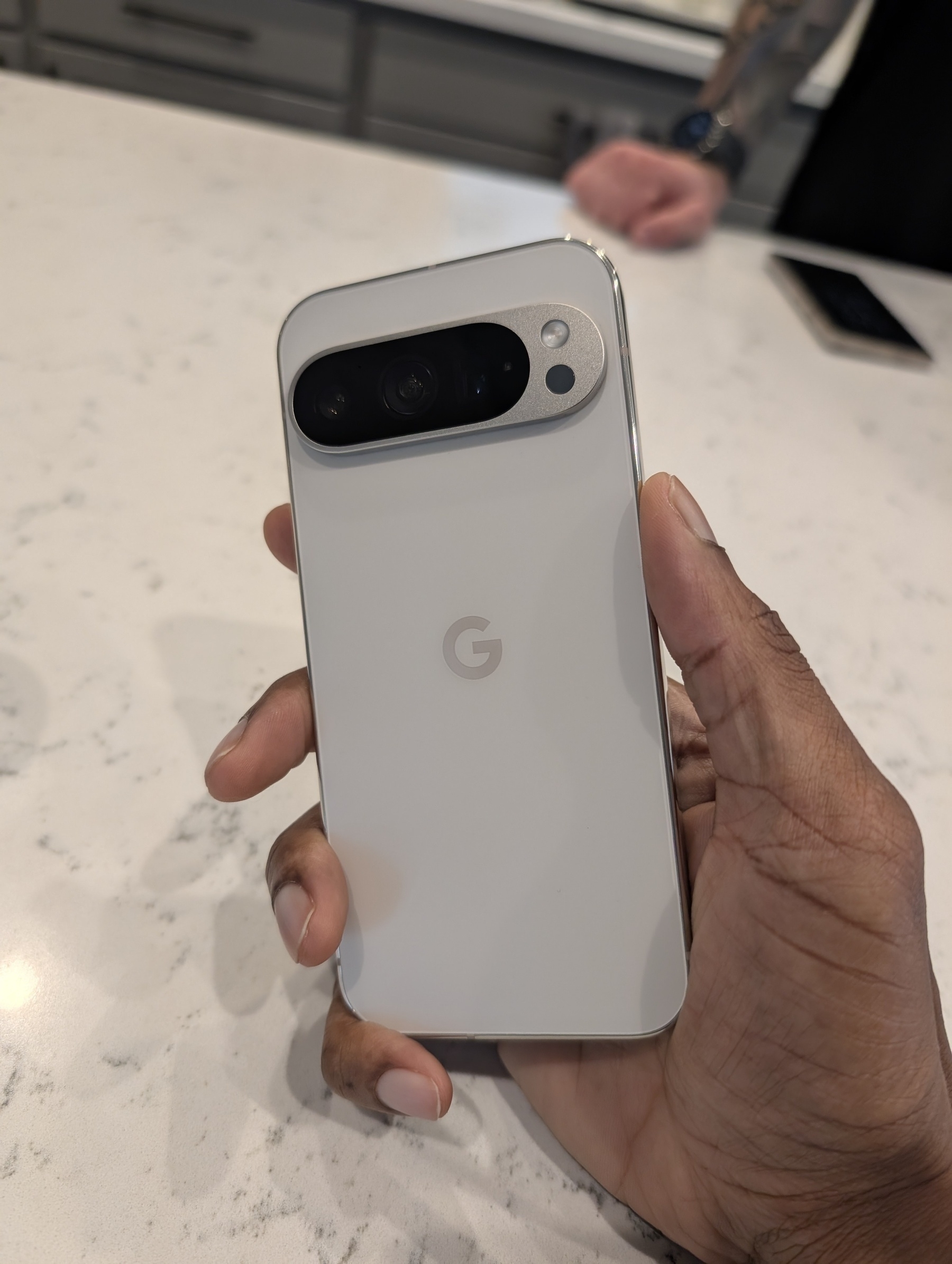
Samsung Galaxy S25 Ultra: Good, Great, ...Meh?
When I think of “Ultra,” I assume it’s the top-tier product in a series. I expect a premium price and a premium experience. This reminds me of the Chromecast Ultra. Despite being 5x less than the price of the S25 Ultra, the upgraded tier from the regular $35 Chromecast gives an idea of what that “Ultra” separation brings: more features, higher quality, etc.
Allison Johnson’s review of the Samsung Galaxy S25 Ultra for The Verge paints a disappointing picture, further defining the “Ultra” space:
“The S24 Ultra downgraded the 10x zoom to a 5x, which is just okay at 10x, despite Samsung’s claims it’s just as good. The S25 Ultra downgrades the smart stylus into a dumb one without Bluetooth connectivity and air control features. I wouldn’t have a problem with that if those things had been sacrificed for some other compelling feature. But I can’t see what’s been added, and at $1,299, this is one of the most expensive phones you can buy that doesn’t fold in half. Don’t get me wrong, it’s a damn good phone. But I think at that price, it’s fair to ask for just a little more.”
You should read the entire review. It suggests to me that Samsung, like Apple, has reached its current peak in smartphone hardware, and Google isn’t far behind as its design language has matured. We’re looking at peak smartphone design now. So much so that Samsung is now removing features that a small minority of people used. Perhaps this is related to potential tariffs, but that’s a topic for another discussion.
A friend who originally pre-ordered the S25 Ultra, coming from the S24 Ultra, has had an entertaining journey. Because there isn’t an immediate difference between the two, he went back and forth with his purchase, taking his followers along for the ride.
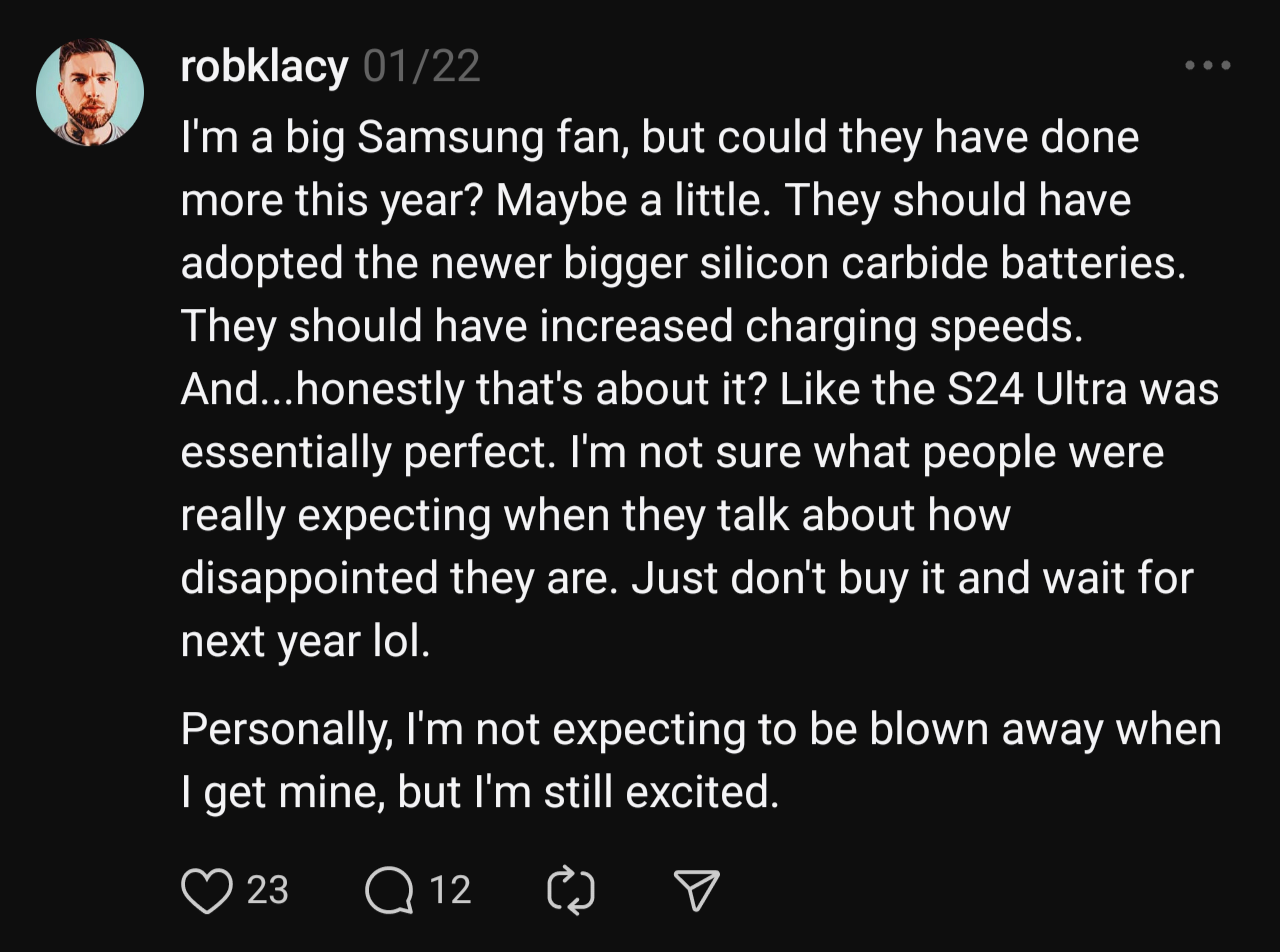
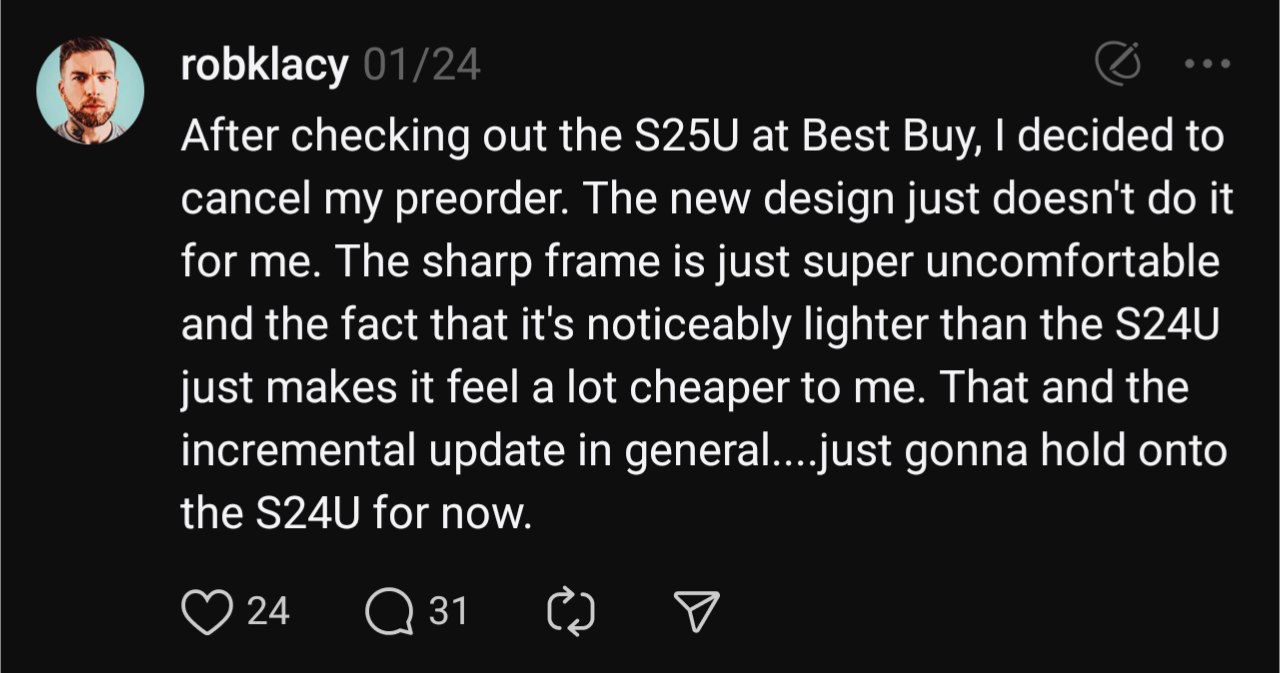
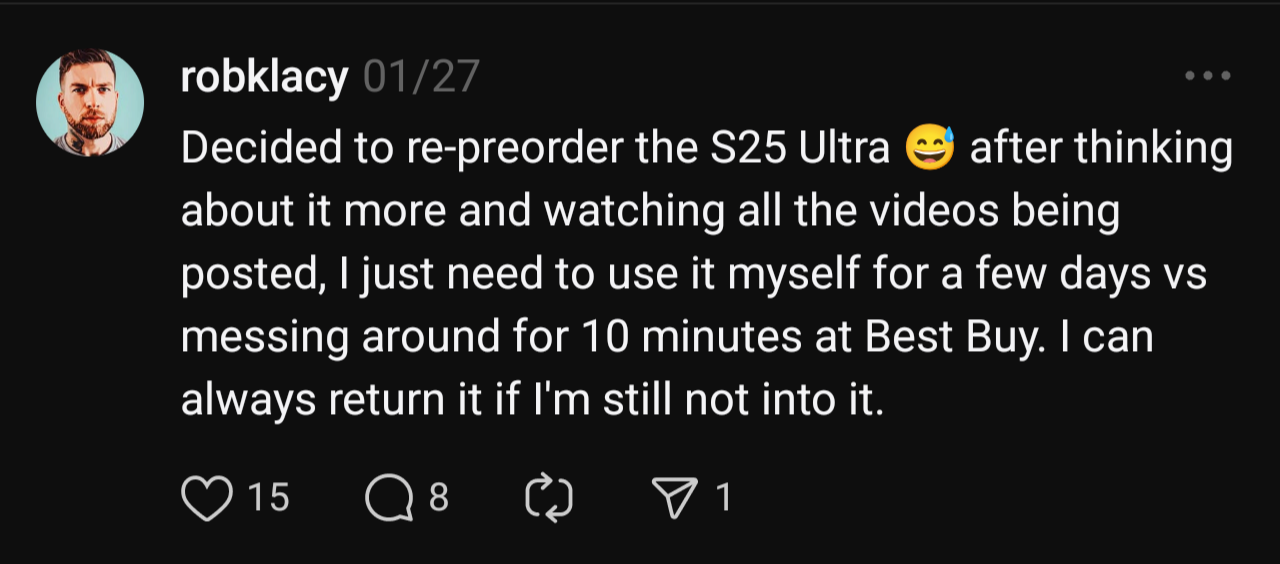
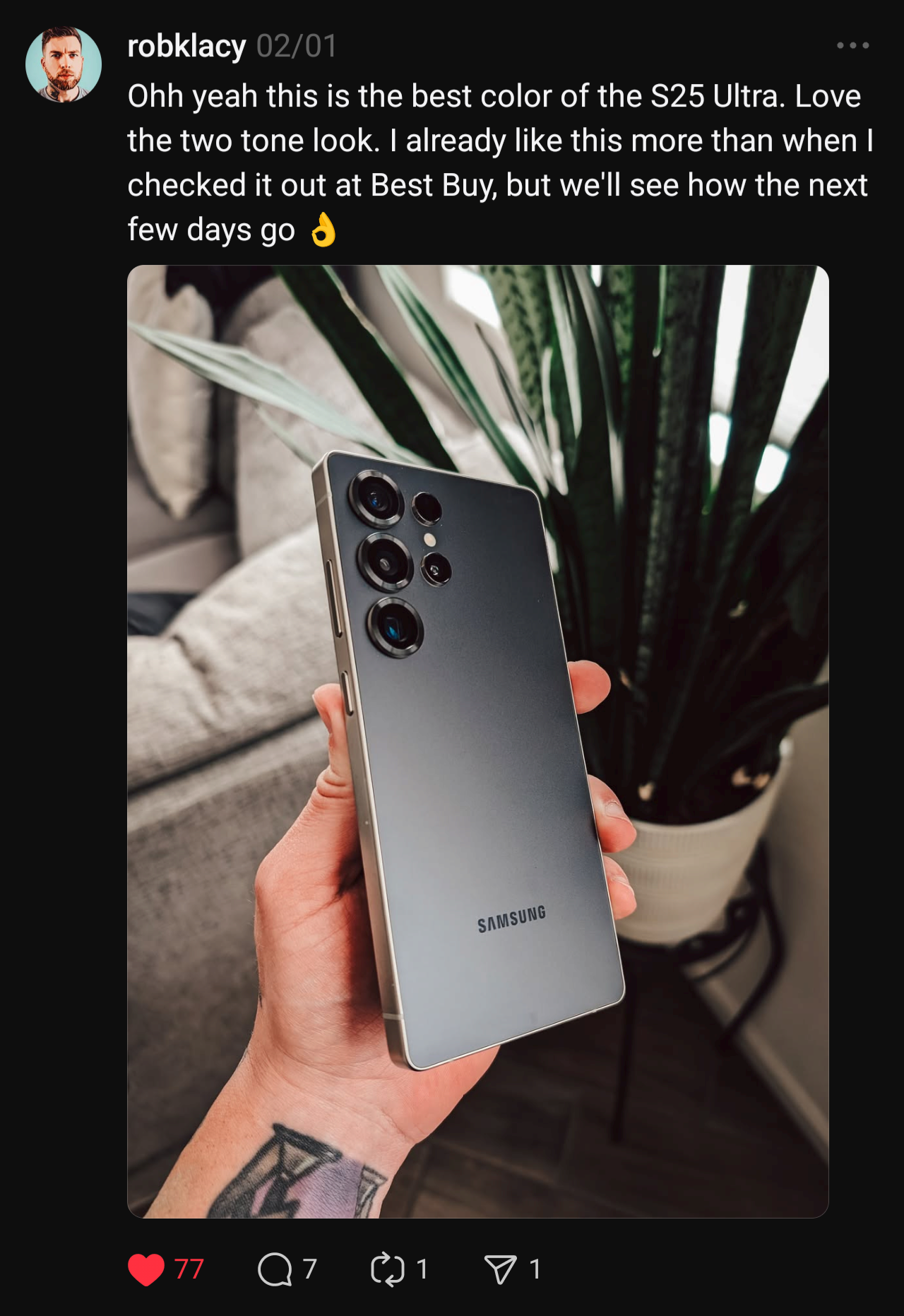
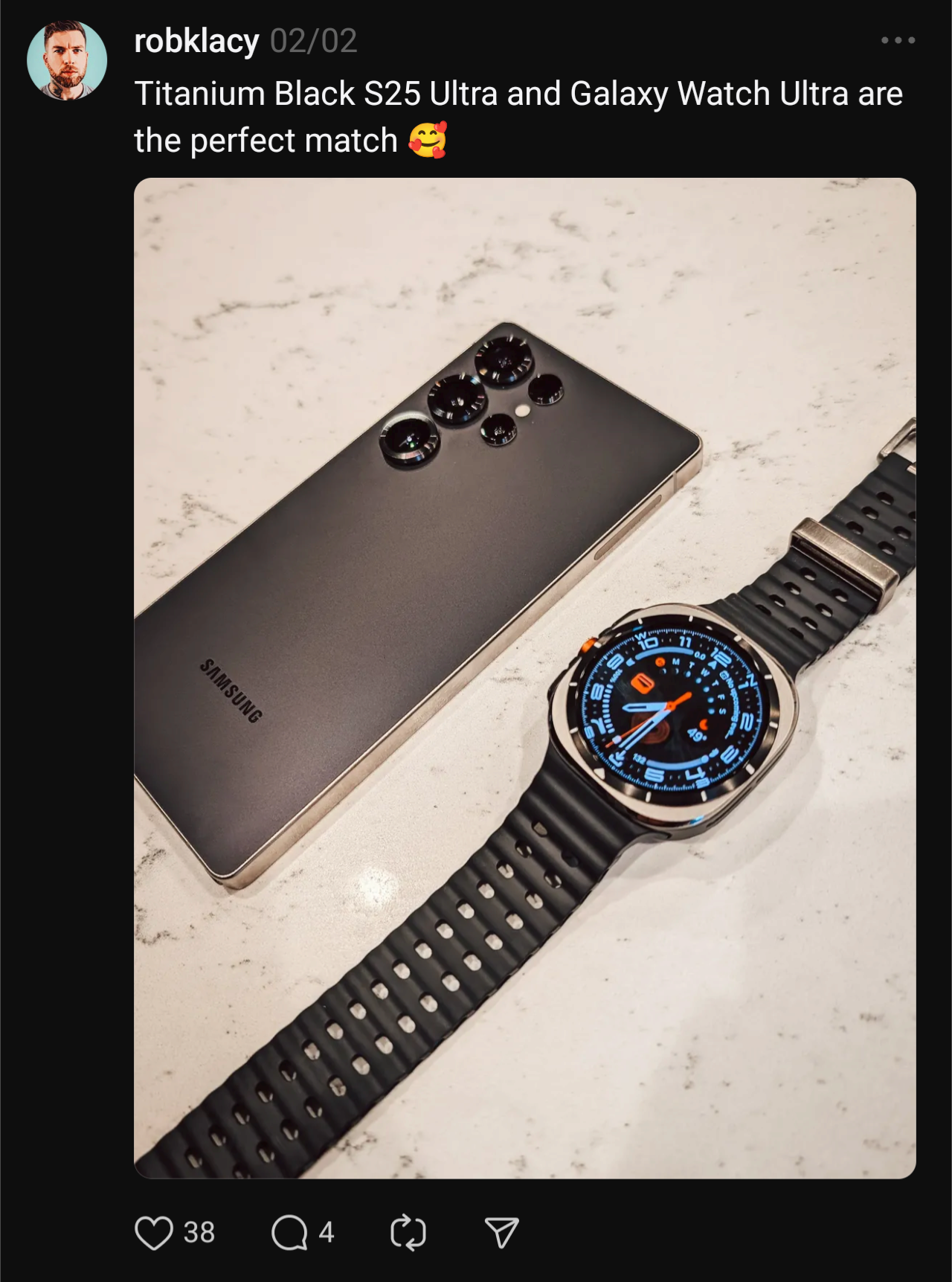
As Rob put it, “Could they (Samsung) have done a little more this year? Maybe a little.” I think so too. However, with all the software, hardware, and AI features that come with the Galaxy S25 Ultra, it truly represents peak smartphone design, especially for the standard smartphone design. The real innovation in hardware comes with the Fold and Flip devices, something Samsung, Google, and OnePlus are pursuing while continuing to optimize and polish their standard form factor phones.
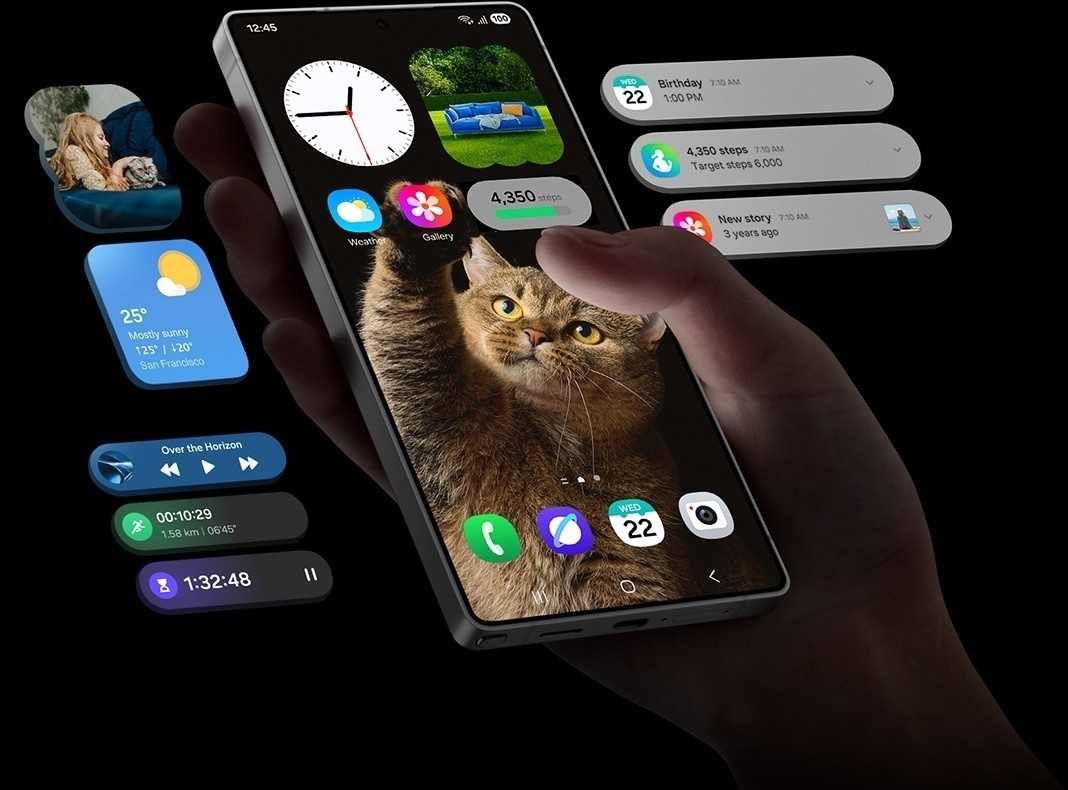
Google Clarifies Some Changes They Made With Calendar
Many people online, myself included, were initially upset about the perceived removal of Black History Month and other culturally relevant days from Google Calendar. It seemed to some like this change reflected a broader societal shift away from diversity, equity, and inclusion. However, that wasn’t the case.
Here’s what Google had to say about the change:
“Some years ago, the Calendar team started manually adding a broader set of moments in a wide number of countries around the world — things like cultural celebrations, teachers days and many more. We got feedback that many other events and countries were missing, and it just wasn’t feasible to put hundreds of moments in everyone’s calendars — so in mid-2024 we made the decision to simplify and show only public holidays and national observances from timeanddate.com. Contrary to some of the comments on social media, this was not something we did just this year.
Some important things to note:
Showing public holidays and national observances, rather than a broader set of moments, is consistent with other major online calendar providers. Google Calendar is also customizable, so users can more easily add important moments to their calendar.
As a company, we continue to celebrate and promote a variety of cultural moments across our products, visible to people everywhere — as you saw in the last few weeks with Black History Month and Lunar New Year.”
I admit, I was duped by these headlines that caused my frustration.
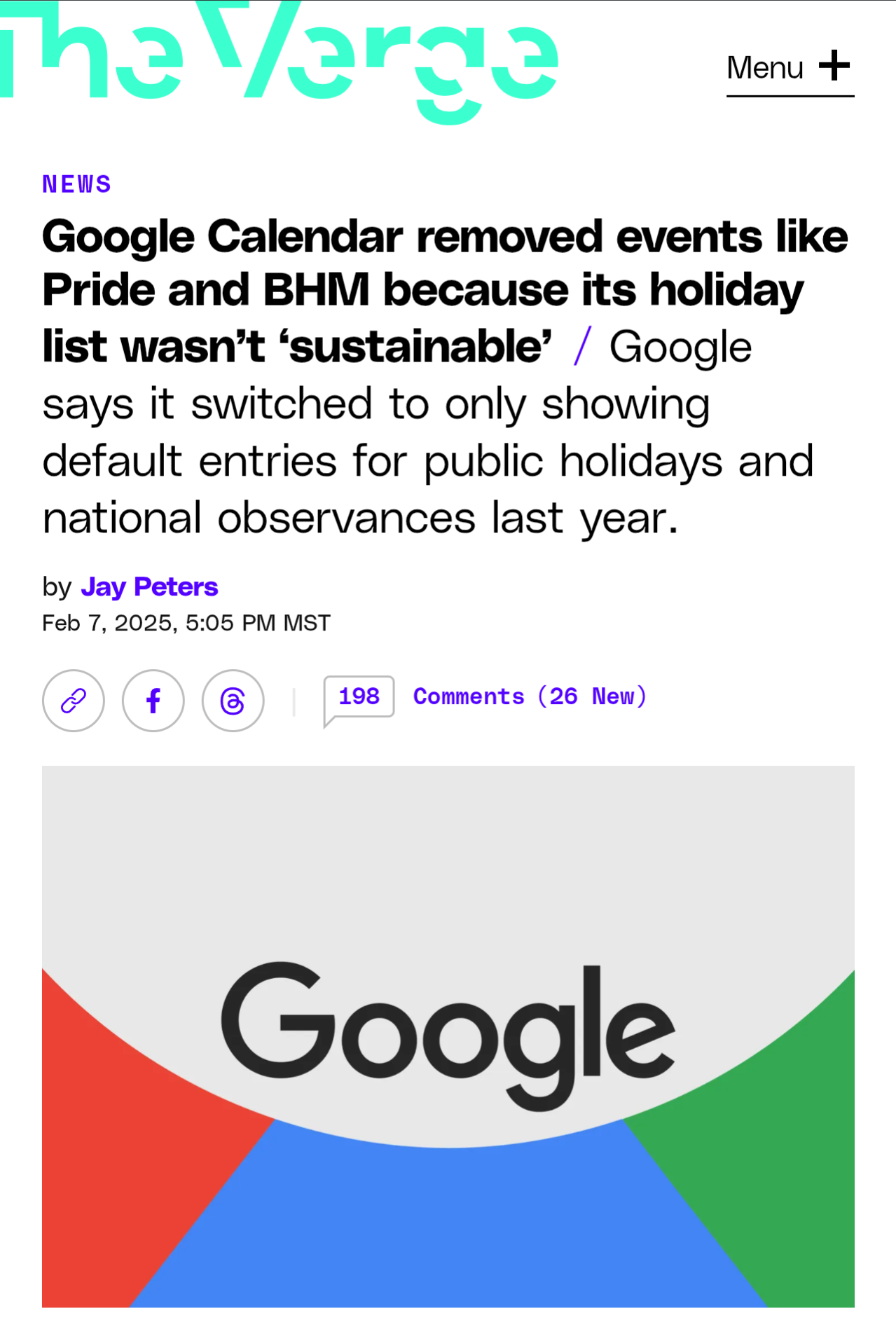
The Verge, specifically, was the first headline and article I read on the subject and I was infuriated. The Verge even made sure to make Google’s clarification on the change as far under the fold and away from the reader’s eyes as possible. The Verge’s article emphasized the negative aspects of the change. Though I don’t like it and Google is still doing things I’m not 100% okay with, it’s stuff like this that happens that frustrates me with The Verge sometimes. Ultimately, as a reader, I need to do a better job at not letting headlines get the best of me.